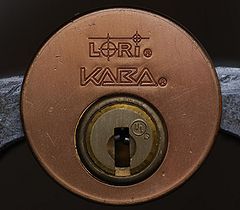KABA Gemini
From Lockwiki
Jump to navigationJump to search
KABA Gemini
| KABA Gemini | |
 | |
| Name | KABA Gemini |
|---|---|
| Manufacturer | KABA |
| Lock Type | Cylinder |
| Lock Design | Dimple, Pin-tumbler |
The KABA Gemini is a UL 437 rated dimple lock designed by KABA and manufactured by the Lori Corporation of Connecticut, USA. The Gemini uses three rows of dimple pins oriented on the left, top, and right sides of the plug. The Gemini is one of the few pin-tumbler locks that is protected against key bumping by design.
The Sargent KESO lock is functionally equivalent to the Gemini.
Principles of operation
The Gemini functions like a standard dimple lock, but it has three sets of active pin-tumblers.
Add to me!
Notes
- Pin chambers are spaced so that rotation does not allow top pins to fall into the other chambers. However, rotation of the plug without a key inserted allows the pin-tumblers to fall into the keyway.
Disassembly instructions
The Gemini is complicated to disassemble because of the several layers between the cylinder and the plug. In addition, the design of the Gemini does not allow a plug follower to be used.
- Remove the cam or C-clip.
- Remove the core retaining screw from the cylinder at 1 o'clock.
- Extract the core
- Remove the core's cam/extension piece (if any)
- Slide the core cover off, be careful to not let any springs or pins fall out.
Notes
- In key-in-knob (KIK) cylinders, the bible is screwed into the core. This must be removed before step 5.
Vulnerabilities
The Gemini may be vulnerable to the following:
Notes
- The design of the Gemini pins and cylinder prevent key bumping attacks.[1]
Gallery
References
- ↑ Fey, Han & Wels, Barry. What the Hack (2005). Bump Proof Locks




